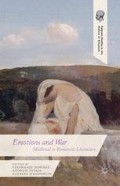Abstract
LaƷamon’s Brut, a Worcestershire poem in English of about 16,000 lines, probably dates from the early thirteenth century, but strongly recalls late Anglo-Saxon in its vocabulary, rhythms and sound patterns.1 It is an energetic adaptation of Wace’s mid-twelfth-century Roman de Brut, which in turn drew its material from a version of Geoffrey of Monmouth’s Historia Regum Britanniae (c. 1136). Much of the poem’s material is about civil war, enemy invasion, foreign conquest, and violent breakdown of the social order, but LaƷamon, more than Geoffrey or Wace, is also interested in peace, not just as an interlude between war episodes, but for its own sake. In a well-known speech by Gawain, amplified and deepened beyond its nature in Wace, the poem states:
for god is grið and god is frið pe freoliche per haldeð wið.
and Godd sulf hit makede purh his Godd-cunde.
for grið makeð godne mon gode workes wurchen.
for alle monnen bið pa bet pat lond bið pa murgre. (lines 12456–459)
[for peace and quiet are good if they are willingly kept, and God himself made peace through his divine nature, for peace makes a good man do good deeds; because all men benefit the land is the happier.]2
My object of study here is the poetic construction of the feeling of peace in LaƷamon. I start with Gawain’s speech because it brings together concisely several of the elements that matter when LaƷamon introduces a peace. They include: set terms like ‘grið’ and ‘frið’ (‘peace’/‘protection’ and ‘quiet’/‘freedom from trouble’); the notion that peace must be freely ‘held’ or ‘kept’; peace as a general condition of happiness and good in the people and the ‘land’; and peace’s connection with the divine.
Access this chapter
Tax calculation will be finalised at checkout
Purchases are for personal use only
Preview
Unable to display preview. Download preview PDF.
Notes
For the similarities in sound patterns, see Rosamund Allen, ‘“Nv seið mid loft-songe”: a re-appraisal of Lawman’s verse form’, in Reading Laʒamon’s Brut. Approaches and Explorations, ed. Rosamund Allen, Jane Roberts and Carole Weinberg (Amsterdam: Rodopi, 2013), 251–82, at 257.
Laʒamon: Brut, ed. G. L. Brook and R. F. Leslie, 2 vols (Oxford: Oxford University Press, 1963, 1978), Early English Text Society OS 250, 277, lines 12456–2459. All intext references to the poem are to line numbers of the Caligula manuscript version in this edition. I have made changes to punctuation. The translations are my own. Referring to this passage, W. R. J. Barron and S. C. Weinburg, Laʒamon’s Arthur. The Arthurian Section of Layamon’s Brut (Exeter: University of Exeter Press, 2001), lxiii, discuss the ‘different idealism [from Wace’s ‘amorous dalliance’] based on social good rather than personal happiness’. C. S. Lewis, in Selections from Laʒamon’s Brut, ed. G. L. Brook (Oxford: Clarendon Press, 1963), ix, notes the Bruts ‘weighty praise of peace’. See Françoise Le Saux, Layamon’s Brut: The Poem and its Sources (Cambridge: D. S. Brewer, 1989), 57, for Laʒamon’s ‘higher sense of the dignity of his subject matter’.
See Andrew Lynch, ‘“Peace is good after war”: The Narrative Seasons of English Arthurian Tradition’, in Writing War: Medieval Literary Responses to Warfare, ed. Corinne Saunders, Françoise Le Saux and Neil Thomas (Woodbridge: Boydell and Brewer, 2004), 127–46.
Sir Gawain and the Green Knight, ed. J. R. R. Tolkien and E. V Gordon, rev. Norman Davis (Oxford: Clarendon Press, 1967), line 18.
Wace’s Roman de Brut. A History of the British, trans. Judith Weiss (Exeter: Exeter University Press, 1999), lines 1501–510.
Rosamund Allen, ‘The Implied Audience of Laʒamon’s Brut’, in The Text and Tradition of Laʒamon’s Brut, ed. Françoise H. M. Le Saux (Cambridge: Boydell and Brewer, 1994), 121–39, at 126.
Psalmi 4: 7–9. Biblia Sacra iuxta Vulgatam Clementinam (Madrid: Biblioteca de Autores Cristianos, 1972); The Holy Bible (Philadelphia: John Potter, 1888), Psalms 4: 7–9.
See Augustine: Confessions, ed. James J. O’Donnell (Oxford: Clarendon Press, 1992), Book 9: 4.11; The Confessions of St Augustine, trans. E. B. Pusey (Oxford: Parker and Rivington, 1838), Book 9: 4, 11.
W. R. J. Barron, ‘The Idiom and the Audience of La3amon’s Brut,’ in Laʒamon: Contexts, Language and Interpretation, ed. Rosamund Allen, Lucy Perry and Jane Roberts (London: King’s College Centre for Late Antique and Medieval Studies, 2002), 157–84, at 172.
See MED, frith (n.(1)). For the various related aspects of medieval peace and protection, both political and religious, see T. B. Lambert, ‘Introduction. Some Approaches to Peace and Protection in the Middle Ages’, in Peace and Protection in the Middle Ages, ed. T. P. Lambert and David Rollason (Durham: Centre for Medieval and Renaissance Studies, 2009), 1–16.
See Rosamund Allen, ‘Did Lawman Nod, or Is It We that Yawn?’, in Reading Layamon’s Brut, ed. Allen et al., 21–52, at 34.
For a discussion of the battle style, see Eric Stanley, ‘Laʒamon’s un-Anglo-Saxon Syntax’, in Layamon’s Brut: Text and Tradition, ed. Le Saux, 47–56, at 54–55.
Layamon’s Brut: A History of the Britons, vol. 65, trans. Donald G. Bzdyl (Binghamton, NY: Medieval and Renaissance Texts and Studies, 1989), 26.
See Jan Plamper, ‘The History of Emotions: An Interview with William Reddy, Barbara Rosenwein, and Peter Stearns’, History and Theory 49.2 (2010): 237–65, at 240.
Editor information
Editors and Affiliations
Copyright information
© 2015 Andrew Lynch
About this chapter
Cite this chapter
Lynch, A. (2015). ‘Blisse wes on londe’: The Feeling of Peace in LaƷamon’s Brut. In: Downes, S., Lynch, A., O’Loughlin, K. (eds) Emotions and War. Palgrave Studies in the History of Emotions. Palgrave Macmillan, London. https://doi.org/10.1057/9781137374073_3
Download citation
DOI: https://doi.org/10.1057/9781137374073_3
Publisher Name: Palgrave Macmillan, London
Print ISBN: 978-1-349-67705-4
Online ISBN: 978-1-137-37407-3
eBook Packages: Palgrave History CollectionHistory (R0)

